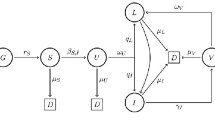Abstract
This manuscript presents the stability analysis of the diarrhea epidemic model with the effect of time delay. The delayed epidemic model for the disease of diarrhea contains four compartments, including susceptible, infective, treated, and recovered classes. The artificial delay parameter is designed with a saturated incidence rate of the model. The mathematical analysis is carried out by studying the equilibria, positivity, boundedness, and reproduction number for the said model. Furthermore, the sensitivity of the parameters is studied to strengthen the mathematical analysis. The diarrhea epidemic model's local and global stabilities are investigated using the acknowledged results of the Routh Hurwitz criterion and Lyapunov function, respectively. Moreover, the numerical results are obtained to support the analysis.









Similar content being viewed by others
Data availability
No data were used in this paper.
References
J. Ardkaew, P. Tongkumchum, Statistical modelling of childhood diarrhea in northeastern Thailand. Southeast Asian J. Trop. Med. Public Health 40(4), 807–815 (2009)
B.R. Cherry, M.J. Reeves, G. Smith, Evaluation of bovine viral diarrhea virus control using a mathematical model of infection dynamics. Prev. Vet. Med. 33(1–4), 91–108 (1998)
P. Collier, G. Conway, T. Venable, Climate change and Africa. Oxf. Rev. Econ. Pol. 24, 337–353 (2008)
H. Auld, D. MacIver, J. Klaassen, Heavy rainfall and waterborne disease outbreaks: the Walkerton example. J. Toxicol. Environ. Health A 67(20–22), 1879–1887 (2004)
R.E. Black, Epidemiology of diarrhoeal disease: implications for control by vaccines. Vaccine 11(2), 100–106 (1993)
A.T. Fuller, Conditions for a matrix to have only characteristic roots with negative real parts. J. Math. Anal. Appl. 23(1), 71–98 (1968)
M. Gatto, L. Mari, A. Rinaldo, Leading eigenvalues and the spread of cholera. SIAM News, 46(7) (2013)
O. Chaturvedi, M. Jeffrey, E. Lungu, S. Masupe, Epidemic model formulation and analysis for diarrheal infections caused by salmonella. SIMULATION 93(7), 543–552 (2017)
M. Farthing, M.A. Salam, G. Lindberg et al., Acute diarrhea in adults and children: a global perspective. J. Clin. Gastroenterol. 47(1), 12–20 (2013)
S.E. Hrudey, P.M. Huck, P. Payment, R.W. Gillham, E.J. Hrudey, Walkerton: lesson learned in comparison with waterborne outbreaks in the developed world. J. Environ. Eng. Sci. 1, 397–407 (2002)
S.M. Pamela. Communicable disease epidemiological, Profile for horn of Africa (2007)
Gunn GJ, Stott AW, Humphry RW. Modeling and costing BVD outbreaks in beef herds. Veterinary J 167:143–149 (2004)
C. Viboud, L. Simonsen, G. Chowell, A generalized-growth model to characterize the early ascending phase of infectious disease outbreaks. Epidemics 15, 27–37 (2016)
B. Lopman, K. Simmons, M. Gambhir, J. Vinje, U. Parashar, Epidemiologic implications of asymptomatic re-infection: a mathematical modeling study of Norovious. Am. J. Epidemiol 179(4) (2013)
E. Bonyah, G. Twagirumukiza, P.P. Gambrah, Mathematical analysis of diarrhoea model with saturated incidence rate. Open J. Math. Sci. 2019(3), 29–39 (2019)
P.R. Hunter, Climate change and waterborne and vector-borne disease. J. Appl. Microbiol. 94, 37–46 (2003)
S. Lenhart, J.T. Workman, Optimal Control Applied to Biological Models (Chapman and Hall/CRC, London, UK, 2007)
G. Innocent et al., A computer simulation of the transmission dynamics and the effects of duration of immunity and survival of persistently infected animals on the spread of bovine viral-diarrhoea virus in dairy cattle. Epidemiol. Infect. 119, 91–100 (1997)
Author information
Authors and Affiliations
Corresponding authors
Ethics declarations
Conflict of interest
The authors declare no conflict of interest.
Rights and permissions
Springer Nature or its licensor (e.g. a society or other partner) holds exclusive rights to this article under a publishing agreement with the author(s) or other rightsholder(s); author self-archiving of the accepted manuscript version of this article is solely governed by the terms of such publishing agreement and applicable law.
About this article
Cite this article
Naveed, M., Raza, A., Soori, A.H. et al. A dynamical study of diarrhea delayed epidemic model: application of mathematical biology in infectious diseases. Eur. Phys. J. Plus 138, 664 (2023). https://doi.org/10.1140/epjp/s13360-023-04287-5
Received:
Accepted:
Published:
DOI: https://doi.org/10.1140/epjp/s13360-023-04287-5




